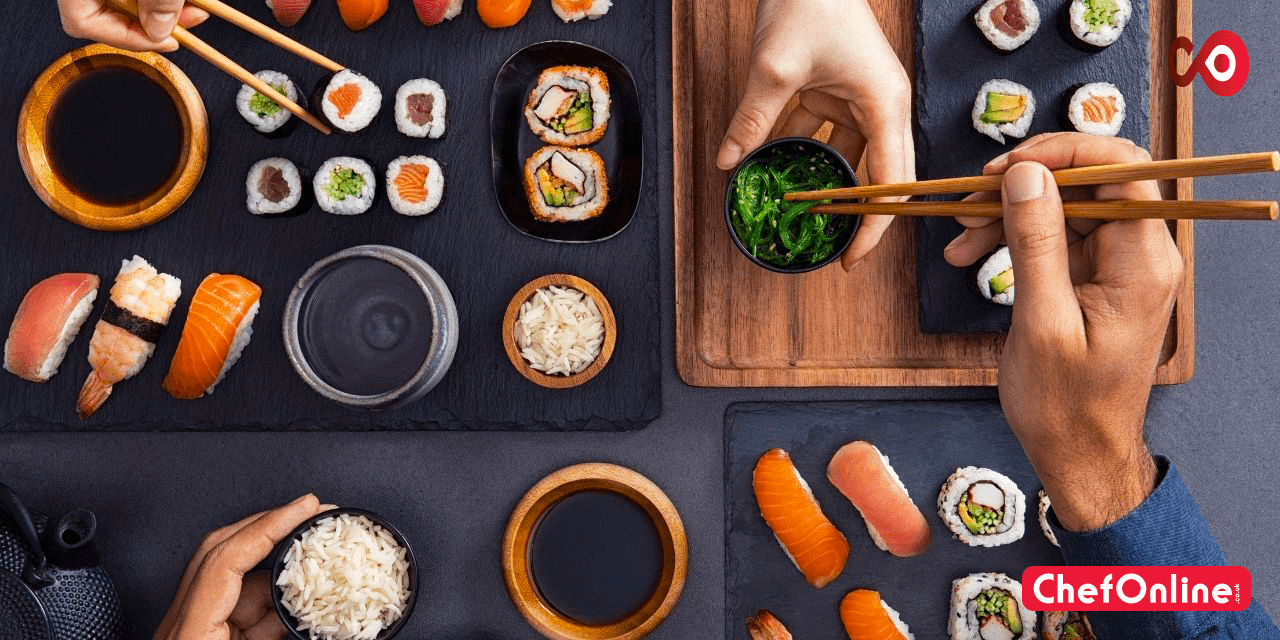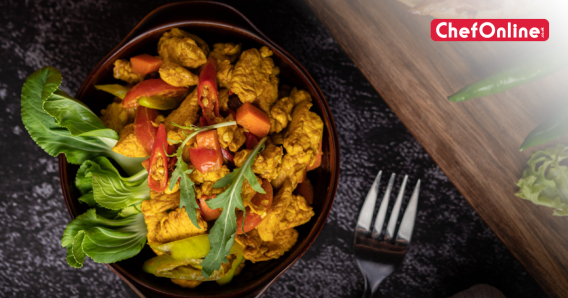Autumn is calling, and what better excuse to celebrate all that’s wonderful about our favourite Japanese dish? To mark the occasion, we’re devoting today’s post to a closer look at the many different mouthwatering forms sushi can take, and at the little rituals that revolve around it.
Made with sticky vinegared rice, raw or cooked fish and/or vegetables, it’s usually served with delicious soy sauce, spicy wasabi and pickled ginger. Sushi is a healthy takeaway treat – and one you’re definitely going to want to order by the time you’ve finished reading this post…
Common types of sushi
Knowing what to order from a sushi menu can be a little tricky, but it’s easy once you learn the basics. Let’s start by taking a look at the most common types of sushi and how you’ll see them referred to on your local Japanese takeaway menu.
Makizushi
Let’s begin with one you’ll recognise. ‘Makizushi’ or ‘norimaki’ is the term given to the most common type of sushi. Makizushi is a roll made of rice pressed into a sheet of nori – toasted seaweed – with a centre of different tasty morsels, such as salmon, spicy tuna, avocado or numerous other ingredients (including plenty of veggie- and vegan-friendly ones).
The word ‘maki’ means ‘to roll’, and there are several variations on this theme. There are two sizes – larger ones called ‘futomaki’, which have several ingredients, and ‘hosomaki’, which are smaller and just have one ingredient – often cucumber or tuna.
A modern variant of this type of sushi is ‘uramaki’, which we know as ‘California rolls’ or ‘inside out rolls’. These have the nori and the rice reversed, so that the sticky sushi rice is on the outside, often coated with sesame seeds or fish eggs. They usually contain salmon or crab, along with avocado or cucumber. You might also find them with tempura. Another type of California roll is the ‘dragon roll’, which has a thin layer of salmon and avocado layered over the top of the roll.
Another delicious maki variant is ‘gunkanmaki’, also known as ‘battleship maki’ because of its shape. It’s similar to regular maki, but the nori sheet extends above the rice to create a sort of well, which is typically filled with various types of fish eggs.
Temaki
It’s that word ‘maki’ again! This time it’s a different type of rolling technique, as temaki takes the form of nori and rice rolled into the shape of an ice cream cone. As with makizushi, there’s loads of variety in the fillings you’ll find in temaki. One of the most popular is salmon and avocado, but there are numerous other possible ingredients, such as crab sticks, tuna, omelette, cucumber or prawns.
Nigiri
Another popular form of sushi is nigiri, which takes the form of rectangular blocks of rice topped with another ingredient, such as fish. These typically come in twos, and the word ‘nigiri’ literally means ‘two fingers’.
Sashimi
It’s sashimi that’s responsible for the common misconception that sushi is just raw fish, because sashimi is, well, just raw fish. If we were going to be pedantic, sashimi doesn’t technically count as sushi at all, because it isn’t created with rice, but it’s a firm favourite among sushi fans and is featured on many a takeaway menu.
Sushi etiquette
Now that we’ve introduced you to the best types of sushi to order, we thought we’d continue this look at the wonderful world of sushi with the lowdown on the sometimes confusing area of sushi etiquette. As with many aspects of Japanese society, there’s a proper way to go about eating sushi, and there’s an almost ceremonial feeling to it. Recreate this at home by keeping the following tips in mind when you get started on your next sushi feast!
How to eat sushi
First of all, if you’re after an authentic Japanese experience then it’s time to bring out the chopsticks, as that’s how most types of sushi are designed to be eaten. You can get away with using your hands for temaki (that’s why they’re often referred to as hand rolls!) and nigiri.
Each piece of sushi – again with the exception of temaki – is designed to be eaten in one bite, so put the whole thing into your mouth rather than biting into it. If you’ve ordered sashimi with your Japanese takeaway, eat this first!
What to do with the soy sauce and wasabi
In some sushi restaurants, the chef will serve each type of sushi with the right amount and type of seasoning, meaning extra soy sauce and wasabi aren’t needed. However, you’ll find that most sushi takeaways will include these so you can season to your own taste.
Many people choose to mix wasabi into their soy sauce in a small dipping dish ready to dip the sushi directly into. Because the sushi rice is made with vinegar, you don’t need to dip the rice bit in soy sauce – and it will disintegrate if you do. Instead, try to dip your sushi on the fish side.
What’s the pickled ginger for?
Finally, in case you’re wondering what to do about the ginger that comes with your takeaway sushi, that’s there to cleanse your palette between different types of sushi. In other words, it’s not meant to be eaten at the same time as sushi or to eat with soy sauce!
If all this talk of sushi has got you in the mood for a Japanese takeaway, head over to ChefOnline and get ordering! A tasty sushi banquet is just a few clicks away.






